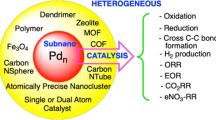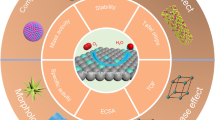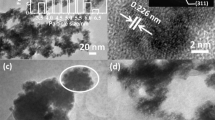Abstract
Bio-inspired metal nanomaterials are receiving increasing research attentions in catalytic field recently, while peptide-based method represents new revenues to fabricate stable and reactive catalyst under mild and environmental friendly conditions. Among all kinds of noble metals, peptide-based palladium nanomaterials have demonstrated excellent catalytic capabilities in a variety of organic reactions. However, their electrocatalytic properties have not been systematically studied. Herein, R5-templated Pd nanomaterials have been fabricated and employed as potent catalysts for oxygen reduction reaction (ORR). The shape and morphology of these Pd nanomaterials were manipulated by tuning the metal-to-R5 ratio. The as-prepared Pd nanomaterials demonstrated excellent ORR activity in alkaline media. R5-Pd-90 exhibited the best activity which is superior than commercial Pt/C, in terms of onset potential, diffusion-limited current density as well as long-term stability. The correlation between the shape and/or morphology of the peptide-templated Pd nanomaterials and their ORR activity has been successfully established.





Similar content being viewed by others
References
Lee YJ, Lee Y, Oh D, Chen T, Ceder G, Belcher AM (2010) Biologically activated noble metal alloys at the nanoscale: for lithium ion battery anodes. Nano Lett 10:2433–2440
Lee Y, Kim J, Yun DS, Nam YS, Shao-Horn Y, Belcher AM (2012) Virus-templated Au and Au–Pt core-shell nanowires and their electrocatalytic activities for fuel cell applications. Energy Environ Sci 5:8328–8334
Chinen AB, Guan CM, Ferrer JR, Barnaby SN, Merkel TJ, Mirkin CA (2015) Nanoparticle probes for the detection of cancer biomarkers, cells, and tissues by fluorescence. Chem Rev 115:10530–10574
Yang X, Yang M, Pang B, Vara M, Xia Y (2015) Gold nanomaterials at work in biomedicine. Chem Rev 115:10410–10488
An K, Somorjai GA (2012) Size and shape control of metal nanoparticles for reaction selectivity in catalysis. ChemCatChem 4:1512–1524
Li G, Jin R (2013) Atomically precise gold nanoclusters as new model catalysts. Acc Chem Res 46:1749–1758
Dickerson MB, Sandhage KH, Naik RR (2008) Protein- and peptide-directed syntheses of inorganic materials. Chem Rev 108:4935–4978
Chen C-L, Rosi NL (2010) Peptide-based methods for the preparation of nanostructured inorganic materials. Angew Chem Int Ed 49:1924–1942
Briggs BD, Knecht MR (2012) Nanotechnology meets biology: peptide-based methods for the fabrication of functional materials. J Phys Chem Lett 3:405–418
Zhang H, Jin M, Xiong Y, Lim B, Xia Y (2013) Shape-Controlled synthesis of Pd nanocrystals and their catalytic applications. Acc Chem Res 46:1783–1794
MaF Akhairi, Kamarudin SK (2016) Catalysts in direct ethanol fuel cell (DEFC): an overview. Int J Hydrog Energy 41:4214–4228
Coppage R, Slocik JM, Sethi M, Pacardo DB, Naik RR, Knecht MR (2010) Elucidation of peptide effects that control the activity of nanoparticles. Angew Chem Int Ed 49:3767–3770
Coppage R, Slocik JM, Briggs BD, Frenkel AI, Heinz H, Naik RR, Knecht MR (2011) Crystallographic recognition controls peptide binding for bio-based nanomaterials. J Am Chem Soc 133:12346–12349
Coppage R, Slocik JM, Ramezani-Dakhel H, Bedford NM, Heinz H, Naik RR, Knecht MR (2013) Exploiting localized surface binding effects to enhance the catalytic reactivity of peptide-capped nanoparticles. J Am Chem Soc 135:11048–11054
Bhandari R, Knecht MR (2011) Effects of the material structure on the catalytic activity of peptide-templated Pd nanomaterials. ACS Catal 1:89–98
Wilson OM, Knecht MR, Garcia-Martinez JC, Crooks RM (2006) Effect of Pd nanoparticle size on the catalytic hydrogenation of allyl alcohol. J Am Chem Soc 128:4510–4511
Crespo-Quesada M, Yarulin A, Jin M, Xia Y, Kiwi-Minsker L (2011) Structure sensitivity of alkynol hydrogenation on shape- and size-controlled palladium nanocrystals: Which sites are most active and selective? J Am Chem Soc 133:12787–12794
Harada T, Ikeda S, Hashimoto F, Sakata T, Ikeue K, Torimoto T, Matsumura M (2010) Catalytic activity and regeneration property of a Pd nanoparticle encapsulated in a hollow porous carbon sphere for aerobic alcohol oxidation. Langmuir 26:17720–17725
Guo S, Zhang S, Sun S (2013) Tuning nanoparticle catalysis for the oxygen reduction reaction. Angew Chem Int Ed 52:8526–8544
Deming CP, Mercado R, Gadiraju V, Sweeney SW, Khan M, Chen S (2015) Graphene quantum dots-supported palladium nanoparticles for efficient electrocatalytic reduction of oxygen in alkaline media. ACS Sustain Chem Eng 3:3315–3323
Jiang G, Zhu H, Zhang X, Shen B, Wu L, Zhang S, Lu G, Wu Z, Sun S (2015) Core/shell face-centered tetragonal FePd/Pd nanoparticles as an efficient non-Pt catalyst for the oxygen reduction reaction. ACS Nano 9:11014–11022
Zhou W, Li M, Ding OL, Chan SH, Zhang L, Xue Y (2014) Pd particle size effects on oxygen electrochemical reduction. Int J Hydrog Energy 39:6433–6442
Tang Y, Chi X, Zou S, Zeng X (2016) Facet effects of palladium nanocrystals for oxygen reduction in ionic liquids and for sensing applications. Nanoscale 8:5771–5779
Jukk K, Alexeyeva N, Sarapuu A, Ritslaid P, Kozlova J, Sammelselg V, Tammeveski K (2013) Electroreduction of oxygen on sputter-deposited Pd nanolayers on multi-walled carbon nanotubes. Int J Hydrog Energy 38:3614–3620
Anderson RM, Yancey DF, Zhang L, Chill ST, Henkelman G, Crooks RM (2015) A theoretical and experimental approach for correlating nanoparticle structure and electrocatalytic activity. Acc Chem Res 48:1351–1357
Narayanan R, El-Sayed MA (2003) Effect of catalysis on the stability of metallic nanoparticles: suzuki reaction catalyzed by PVP-palladium nanoparticles. J Am Chem Soc 125:8340–8347
Naresh N, Wasim FGS, Ladewig BP, Neergat M (2013) Removal of surfactant and capping agent from Pd nanocubes (Pd-NCs) using tert-butylamine: its effect on electrochemical characteristics. J Mater Chem A 1:8553–8559
Bhandari R, Coppage R, Knecht MR (2012) Mimicking nature’s strategies for the design of nanocatalysts. Catal Sci Technol 2:256–266
Yang H, Tang Z, Yan W, Wang L, Wang Q, Zhang Y, Liu Z, Chen S (2017) Peptide capped Pd nanoparticles for oxygen electroreduction: strong surface effects. J Alloys Compd 702:146–152
Knecht MR, Wright DW (2003) Functional analysis of the biomimetic silica precipitating activity of the R5 peptide from Cylindrotheca fusiformis. Chem Commun (24):3038–3039
Sewell SL, Wright DW (2006) Biomimetic synthesis of titanium dioxide utilizing the R5 peptide derived from cylindrotheca fusiformis. Chem Mater 18:3108–3113
Cole KE, Ortiz AN, Schoonen MA, Valentine AM (2006) Peptide- and long-chain polyamine- induced synthesis of micro- and nanostructured titanium phosphate and protein encapsulation. Chem Mater 18:4592–4599
Naik RR, Whitlock PW, Rodriguez F, Brott LL, Glawe DD, Clarson SJ, Stone MO (2003) Controlled formation of biosilica structures in vitro. Chem Commun (2):238–239
Bhandari R, Knecht MR (2012) Synthesis, characterization, and catalytic application of networked au nanostructures fabricated using peptide templates. Catal Sci Technol 2:1360–1366
Debe MK (2012) Electrocatalyst approaches and challenges for automotive fuel cells. Nature 486:43–51
Kraytsberg A, Ein-Eli Y (2014) Review of advanced materials for proton exchange membrane fuel cells. Energy Fuels 28:7303–7330
Winter M, Brodd RJ (2004) What are batteries, fuel cells, and supercapacitors? Chem Rev 104:4245–4270
Peighambardoust SJ, Rowshanzamir S, Amjadi M (2010) Review of the proton exchange membranes for fuel cell applications. Int J Hydrog Energy 35:9349–9384
Bhandari R, Pacardo DB, Bedford NM, Naik RR, Knecht MR (2013) Structural control and catalytic reactivity of peptide-templated Pd and Pt nanomaterials for olefin hydrogenation. J Phys Chem C 117:18053–18062
Gu H, Ma C, Gu J, Guo J, Yan X, Huang J, Zhang Q, Guo Z (2016) An overview of multifunctional epoxy nanocomposites. J Mater Chem C 4:5890–5906
Creighton JA, Eadon DG (1991) Ultraviolet-visible absorption spectra of the colloidal metallic elements. J Chem Soc, Faraday Trans 87:3881–3891
Coppage R, Slocik JM, Briggs BD, Frenkel AI, Naik RR, Knecht MR (2012) Determining peptide sequence effects that control the size, structure, and function of nanoparticles. ACS Nano 6:1625–1636
He G, Song Y, Liu K, Walter A, Chen S, Chen S (2013) Oxygen reduction catalyzed by platinum nanoparticles supported on graphene quantum dots. ACS Catal 3:831–838
Alexeyeva N, Sarapuu A, Tammeveski K, Vidal-Iglesias FJ, Solla-Gullón J, Feliu JM (2011) Electroreduction of oxygen on Vulcan carbon supported Pd nanoparticles and Pd–M nanoalloys in acid and alkaline solutions. Electrochim Acta 56:6702–6708
Deming CP, Zhao A, Song Y, Liu K, Khan MM, Yates VM, Chen S (2015) Alkyne-protected AuPd alloy nanoparticles for electrocatalytic reduction of oxygen. ChemElectroChem 2:1719–1727
Wang Q, Tang Z, Wang L, Yang H, Yan W, Chen S (2016) Morphology control and electro catalytic activity towards oxygen reduction of peptide-templated metal nanomaterials: a comparison between Au and Pt. ChemistrySelect 1:6044–6052
Yan W, Tang Z, Wang L, Wang Q, Yang H, Chen S (2017) PdAu alloyed clusters supported by carbon nanosheets as efficient electrocatalysts for oxygen reduction. Int J Hydrog Energy 42:218–227
Zadick A, Dubau L, Demirci UB, Chatenet M (2016) Effects of Pd nanoparticle size and solution reducer strength on Pd/C electrocatalyst stability in alkaline electrolyte. J Electrochem Soc 163:F781–F787
Wang L, Tang Z, Yan W, Wang Q, Yang H, Chen S (2017) Co@Pt Core@Shell nanoparticles encapsulated in porous carbon derived from zeolitic imidazolate framework 67 for oxygen electroreduction in alkaline media. J Power Sources 343:458–466
Ding L-X, Wang A-L, Li G-R, Liu Z-Q, Zhao W-X, Su C-Y, Tong Y-X (2012) Porous Pt–Ni–P composite nanotube arrays: highly electroactive and durable catalysts for methanol electrooxidation. J Am Chem Soc 134:5730–5733
Zhou Z-Y, Kang X, Song Y, Chen S (2011) Butylphenyl-functionalized palladium nanoparticles as effective catalysts for the electrooxidation of formic acid. Chem Commun 47:6075–6077
Zhang X, Xiao Q, Zhang Y, Jiang X, Yang Z, Xue Y, Yan Y-M, Sun K (2014) La2O3 doped carbonaceous microspheres: a novel bifunctional electrocatalyst for oxygen reduction and evolution reactions with ultrahigh mass activity. J Phys Chem C 118:20229–20237
Tang W, Lin H, Kleiman-Shwarsctein A, Stucky GD, Mcfarland EW (2008) Size-dependent activity of gold nanoparticles for oxygen electroreduction in alkaline electrolyte. J Phys Chem C 112:10515–10519
Chen W, Chen S (2009) Oxygen electroreduction catalyzed by gold nanoclusters: strong core size effects. Angew Chem Int Ed 48:4386–4389
Kondo S, Nakamura M, Maki N, Hoshi N (2009) Active sites for the oxygen reduction reaction on the low and high index planes of palladium. J Phys Chem C 113:12625–12628
Xiao L, Zhuang L, Liu Y, Lu J, Abruña HD (2009) Activating Pd by morphology tailoring for oxygen reduction. J Am Chem Soc 131:602–608
Shao M, Yu T, Odell JH, Jin M, Xia Y (2011) Structural dependence of oxygen reduction reaction on palladium nanocrystals. Chem Commun 47:6566–6568
Shao M, Odell J, Humbert M, Yu T, Xia Y (2013) Electrocatalysis on shape-controlled palladium nanocrystals: oxygen reduction reaction and formic acid oxidation. J Phys Chem C 117:4172–4180
Erikson H, Sarapuu A, Tammeveski K, Solla-Gullón J, Feliu JM (2011) Enhanced electrocatalytic activity of cubic Pd nanoparticles towards the oxygen reduction reaction in acid media. Electrochem Commun 13:734–737
Erikson H, Sarapuu A, Alexeyeva N, Tammeveski K, Solla-Gullón J, Feliu JM (2012) Electrochemical reduction of oxygen on palladium nanocubes in acid and alkaline solutions. Electrochim Acta 59:329–335
Acknowledgements
Z. H. T acknowledges financial support from the National Natural Science Foundation of China (No. 21501059), Project of Public Interest Research and Capacity Building of Guangdong Province (2015A010105009), Guangdong Natural Science Funds for Distinguished Young Scholars (No. 2015A030306006) as well as Guangdong Innovative and Entrepreneurial Research Team Program (No. 2014ZT05N200). S. W. C. thanks the National Science Foundation for partial support of the work (CHE-1265635 and DMR-1409396).
Author information
Authors and Affiliations
Corresponding authors
Electronic supplementary material
Below is the link to the electronic supplementary material.
10853_2017_1004_MOESM1_ESM.docx
Supplementary material 1 Electron transfer number comparison calculated by different methods, UV–visible absorbance, size distribution histogram of PdNPs, LSV curves of R5-templated Pd nanomaterials at the rotation rates of 100–2500 rpm, K–L plots, Tafel plots, ECSA tests and mass activity comparison with commercial Pt/C. (DOCX 1169 kb)
Rights and permissions
About this article
Cite this article
Yang, H., Wen, C., Tang, Z. et al. Shape and structural effects of R5-templated Pd nanomaterials as potent catalyst for oxygen electroreduction in alkaline media. J Mater Sci 52, 8016–8026 (2017). https://doi.org/10.1007/s10853-017-1004-y
Received:
Accepted:
Published:
Issue Date:
DOI: https://doi.org/10.1007/s10853-017-1004-y




